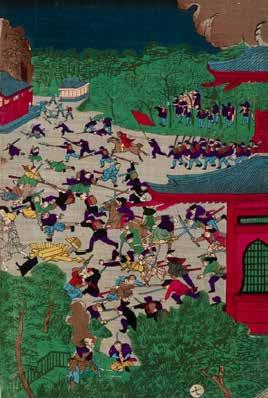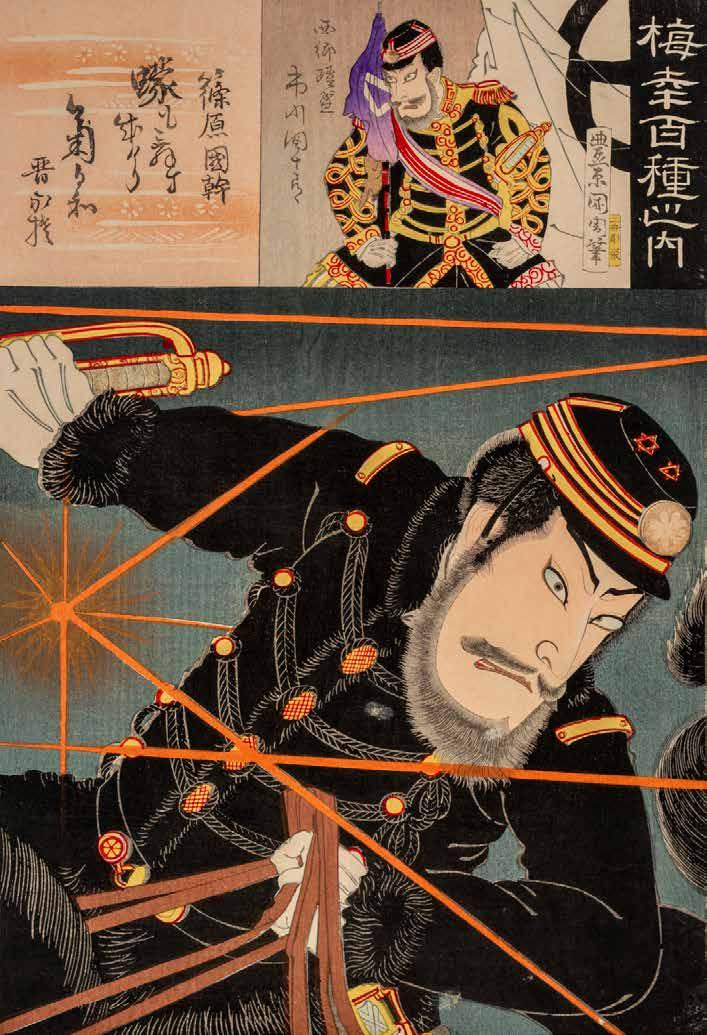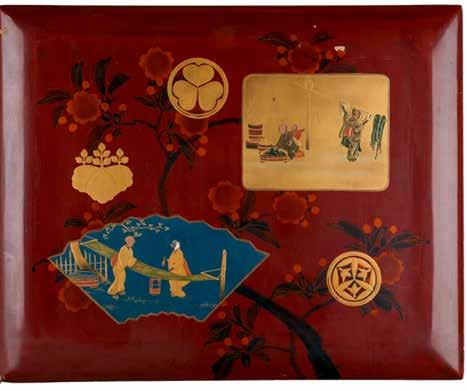
13 minute read
The last samurai: Saigō Takamori 西郷 隆盛 (1828–1877
Jennifer Harris
By the mid-nineteenth century, in the period known as the Bakumatsu (1853–67), the military government (bakufu) established by the Tokugawa shogunate was in decline. The backbone of the bakufu, the samurai class, had become militarily and socially irrelevant. Weakened by domestic food shortages and external foreign threats, in 1858 the shogun was forced to accept the opening of foreign treaty ports, much against the wishes of the populace. Under the slogan of ‘Revere the Emperor, Expel the Barbarians’ (Sonnō Jōi), the notion of restoring the Emperor to power was gaining momentum.
Advertisement
After more than 670 years of samurai rule and 260 years of rule by the Tokugawa shogunate, the last shogun, Tokugawa Yoshinobu (1837–1913), relinquished power, on 9 November 1867, in the hope that a political alliance with the Emperor would eventuate. 1 Instead, a civil war between daimyo, loyal to the shogun, and ‘outside’ lords (tōzama), loyal to the Emperor, began with an attack on the Emperor’s centre of power in Kyoto. The Boshin war (27 January 1868 – 27 June 1869) involved numerous skirmishes and battles, the most decisive being the Battle of Ueno, in the capital of Edo, on 15 May 1868.
fig. 1, detail: Utagawa Yoshitora, Japan, active 1840–1880, Illustration of the great battle of Tōdai (todai daisenso no zu), 1874, colour woodblock print (nishiki-e), ink and colour on paper, nine sheets, 35.5 x 137 cm; On loan from David Forrest and Jánis Nedéla, Perth
1 Donald Keene, Emperor of Japan: Meiji and his world 1852–1912, Columbia University Press, New York, 2002, pp. 116, 117.


The abbot, Rinnōjinomiya, was a prince who, from a young age, had entered the Buddhist Tendai sect. For details on his escape, see Keene, pp.148–54. Ivan Morris, ‘The apotheosis of Saigō the Great’, The nobility of failure, Martin Secker and Warburg, UK, 1975, p. 227.
After the capitulation of the shogun in 1867, Edo castle was vacated and disgruntled supporters gathered in Ueno. When the battle commenced, Kaneiji Temple, the shogun’s personal temple, was attacked.
The woodblock print artist Utagawa Yoshitora (active 1840–1880) records the full extent of the Battle of Ueno in a spectacular panorama of nine panels (fig. 1). Samurai fighting for the Emperor are dressed in Western-style military uniforms and are armed with modern guns and bayonets. They were a coalition of tōzama clans, the Satsuma, Chōshū and Tosa, from outside the political and cultural centre of Edo. The Tosa clan from Shikoku can be identified by their distinctive red-bear wigs (shaguma), while the shogun’s troops are wearing clothing appropriate to samurai and are armed with swords and long poles (naginata).
Amidst the chaos, the Buddhist monks of Kaneiji Temple escape, carrying treasures from the temple; defeated samurai commit suicide; the temple is razed to the ground and the air is filled with smoke. In the lower left panel, a figure dressed in a straw coat and protected by soldiers makes his escape. This is most likely the abbot, Rinnōjinomiya (1847–1894), who had returned to the temple days earlier, from Kyoto, after unsuccessfully pleading with imperial forces for the safe passage of the shogun. 2
The imperial victory cemented the beginning of the Meiji Restoration (1868–1912), with the fifteen-year-old Mutsuhito enthroned as Emperor Meiji (1852–1912). Two months after the battle, Edo became Tokyo, ‘eastern capital’.
The chief architect of the coalition of tōzama clans and leader of the victorious battle was Saigō Takamori (1828–1877), an impoverished samurai of the Shimazu clan from Satsuma domain in southern Kyushu. Saigō Takamori is often referred to as ‘the last samurai’ and the story of his life and accomplishments inspired such devotion that he attained legendary status. This is eloquently depicted in woodblock prints created after his death in 1877, which recognise his role in the birth of the modern nation of Japan, as well as his ability to maintain values considered consistent with the samurai.
Saigō Takamori was born in the Satsuma domain (present-day Kagoshima prefecture) on the island of Kyushu, ruled by the formidable Shimazu clan. During the battles to unify the Japanese archipelago in the sixteenth century, the Shimazu clan had opposed the victorious Tokugawa and as a result were viewed as an ‘outside’ (tōzama) clan. The Shimazu were distrustful of the shogunate and were fiercely independent.
The Satsuma domain was populated by an abundance of samurai and this had a profound influence on Saigō Takemori’s own values and education. 3 Frugality and valour were values shared by both samurai and peasants. Physically, Saigō Takamori was extremely tall; he was charismatic and a powerful fighter. His formal education was typical of the samurai class and encompassed the humanistic study of classical Chinese texts and state-endorsed Zhu Xi Confucianism. These studies provided the means by which samurai could exclusively enter the services of daimyo lords.
In 1849 the Shimazu clan was split by a succession dispute. Saigō supported the appointment of Shimazu Nariakira (1809–1858), who became Lord of Satsuma in 1851. Lord Nariakira and the lowly samurai, Saigō, travelled to Edo together in 1854 as part of their biannual
obligation to the shogun, known as alternate attendance (sankin kōtai). 4 On their way along the main Tōkaidō highway, it is possible that Saigō witnessed first-hand or heard of the ‘black ships’ of Commodore Matthew Perry (1794–1858), anchored in Kanagawa, which ultimately forced the shogunate to open Japan to foreign ships. 5
Edo was a confusing, overcrowded city, given to rumours and intrigue. Nonetheless, Saigō’s reputation and diplomatic skills in the service of Nariakira were well respected. In 1858, however, Nariakira died and Saigō planned to commit suicide to be with his lord. He was dissuaded by his friend Gesshō (1813–1858), a Buddhist priest at Kiyomizu Temple in Kyoto, who was a loyalist conspiring to overthrow the shogun and restore the Emperor. An arrest warrant was issued and Gesshō fled with Saigō to Satsuma, where he unsuccessfully sought protection. The two men boarded a boat with the intention of committing double suicide in Kagoshima Bay. Gesshō drowned but Saigō was rescued.
In the turmoil of the declining shogunate and the advent of a new, unsympathetic Satsuma lord, Hisamitsu (1817–1887), Saigō was banished twice for a total of five years between 1859 and 1864 to the distant Ryukyu islands, present-day Okinawa. In exile and on his return to Satsuma, he actively opposed the extreme poverty and slavery he found there, also setting up schools for local children.
As further evidence of the vicissitudes of life during the turmoil of the Bakumatsu, Saigō was unexpectedly released from exile by Lord Hisamitsu. A month after his triumphant return to Kagoshima, he was appointed Satsuma War Secretary, to be based in Kyoto. This post enabled him to confer with the British government through Sir Harry Smith Parkes (1828–1885), the British Plenipotentiary, and the diplomat, Ernest Satow (1843–1929). The British supported the anti-shogunate stand of the Satsuma domain, providing weapons. 6
Saigō’s reputation continued to soar. His frugality and samurai spirit were demonstrated publicly with his refusal of any honours or rewards from the new Meiji government. 7 By the 1870s, while he continued to exercise supreme military power, he wearied of the seemingly endless political skirmishes. His simple lifestyle, in which he eschewed the money and opulence of other Meiji bureaucrats, contributed to his popular appeal and reputation amongst alienated samurai.
Having won the Battle of Ueno and victory for the restoration of the Emperor, the new regime did not, however, live up to its promises in the eyes of the Emperor’s staunchest allies, the Satsuma and Chōshū clans. Although the clans had supported the Emperor as a means to keep foreigners out of Japan, this did not happen. Furthermore, Meiji modernisation had resulted in the loss of feudal domains and samurai privileges. In 1872, for reasons of equality, the newly formed Imperial Japanese Army recruited commoners, thereby depriving the samurai of their function in society. In 1876, samurai not only lost hereditary privileges but also had to relinquish their swords, cut their distinctive topknot hair and suffer the indignity of having to wear Western clothing.
Seven hundred years of samurai culture had become cause for embarrassment. Modernity had corrupted and threatened to destroy the samurai spirit. While Saigō represented the last vestige of samurai
fig. 2: Kunichika Toyohara, 1835–1900, Onoe Kikugoro V as Shinohara Kunimoto, from the series One hundred roles of Baiko (Baikohyakushu no uchi), 1893, colour woodblock print (nishiki-e); ink and colour on paper, 37.0 x 25.0 cm; d’Auvergne Boxall Bequest Fund 2013
4
5
6 Sankin kōtai ‘alternate attendance’ system began in 1635. Feudal lords had to reside in Edo for several months every two years leaving their families behind as hostages. Mark Ravina, The last samurai: the life and battles of Saigō Takamori, John Wiley and Sons, New Jersey, 2004, p. 53; in 1854 the Treaty of Kanagawa opened the treaty ports of Hakodate and Shimoda to American ships, thereby increasing the instability of the shogunate. The French supported the pro-shogun forces. After the Battle of Ueno was lost, the shogunal forces escaped to Hokkaido (Ezo) with the intent of declaring a separate republic. Morris, p. 241.

principles, in reality he had endorsed many of the changes, possibly without understanding their full consequences. Despite the obvious contradictions, disenfranchised samurai turned to Saigō as a potential leader to air their grievances.
After 1873 he turned to life in Kagoshima prefecture (formerly Satsuma domain) and organised a number of private schools for several thousand students, whose education comprised training in the military arts – both traditional and modern – agriculture and morals, based on Buddhism and Confucianism. The schools operated on Saigō’s basic tenet ‘Revere Heaven, Love Humanity’ (keiten aijin).
A key person involved in the delivery of the military training in the schools was Shinohara Kunimoto (1836–1877), who is depicted with Saigō Takamori in a Kabuki actor print by Kunichika Toyohara (1835–1900) (fig. 2). This print, Onoe Kikugoro V as Shinohara Kunimoto, created in 1893, depicts Japan’s most famous actors of the period, Ichikawa Danjurō IX in the role of Saigō (above), and Onoe Kikugorō V as Shinohara (below). Both men are shown in imperial uniforms, fighting for the Emperor before their ill-fated defection to the Satsuma Rebellion in 1877.
It is generally believed that Shinohara used his position to recruit students in the schools established by Saigō Takamori to take advantage of the social unrest in the former Satsuma and Chōshū domains.
The students banded together and, without Saigō’s knowledge, attacked the imperial arsenals in Kagoshima. This act of rebellion was the impetus for the Satsuma Rebellion, with Saigō as its unwilling leader. The Satsuma rebels were heavily outnumbered by the conscripted Imperial Army, which also included eleven warships. The Satsuma Rebellion’s illadvised siege of Kumamoto Castle lasted only twenty days and Kagoshima quickly fell to imperial forces. Saigō and his remaining forces withdrew to caves on Shiroyama, which overlooked Kagoshima Bay, where Saigō was killed on 24 September 1877.
The circumstances of his death are controversial: it is generally accepted by historians that, having been shot in the groin, he was decapitated by his deputy Beppu Shinsuke (1842–1877) to evade capture. His head was hidden to avoid its becoming a trophy for government forces.
Even before his death, woodblock print artists, including those employed by the rising number of newspapers in the Meiji era, became obsessed with Saigō and the Satsuma Rebellion, which threatened to destabilise the government. One of the most innovative and prolific woodblock print artists of the Meiji era, Kiyochika Kobayashi (1847–1915), depicted the famous journalist Fukuchi Gen’ichirō (1841–1906) standing on Shiroyama reporting on the action around him, as imperial soldiers attacked Saigō’s rebels (fig. 3).
One of the more evocative print designs demonstrating the popular appeal of Saigō Takamori was created by Utagawa Kunimasa (1848–1920) prior to Saigō’s death on 15 August 1877. The print (fig. 4), which links his ascension to the heavens – literally and metaphorically – with a comet that appeared in the southwestern sky on 2 August 1877, depicts a commonly held belief that Saigō had ‘risen’ to become a star. An Osaka newspaper reported that through a telescope you could see Saigō sitting
fig. 3: Kiyochika Kobayashi, Japan, 1847–1915, The journalist Fukuchi Gen’ichirō, no. 45 from the series Instructive models of lofty ambition (Kyōdō risshiki), 1885, woodblock print, ink and colour on paper, 36.1 x 24.5 cm; d’Auvergne Boxall Bequest Fund 2013

on a star ‘healthy, fit and in full imperial uniform’. 8 In addition to this celestial phenomenon, in August and September the planet Mars was close to earth and shone very brightly. At the time, John Reddie Black (1826–1880), formerly of Adelaide, an English language newspaper editor in Yokohama and the author of Young Japan: Yokohama and Yedo, 1858–79, commented: ‘in the popular belief, the spirit of their once great general has taken up its abode in the planet Mars and his figure may there be seen, when this star is in the ascendant’. 9
Public sympathy for Saigō and his cause was very strong. Even the leading reformer and architect of Westernisation in Meiji Japan, Fukuzawa Yukichi (1835–1901), was of the opinion that Saigō had been driven to death by the government’s tyranny. 10 Although Saigō was officially a traitor, on the occasion of the proclamation of the constitution in 1889, he was pardoned posthumously by Emperor Meiji and was elevated to a court rank normally reserved for high nobles. Two years later, during the visit of Crown Prince Nikolai of Russia (1868–1918; later, Czar Nicholas II), rumours were circulating that Saigō had escaped and was sheltering in Russia. It had been anticipated by Saigō’s followers that he would return on a Russian naval ship with Nikolai. When he did not materialise, a policeman tried to assassinate Nikolai, provoking an international incident.
Saigō’s life and death were full of contradictions. Alive, he had been an enemy of the shogun, and in death, he was regarded as a traitor by the Meiji government, for whom he had fought valiantly. His heroic samurai spirit became a commodity, a focus of nostalgia, which continues to endure. His statue in Ueno Park – the scene of the major battle – showing him in simple clothing, walking with his dog, became a site of pilgrimage. In the aftermath of the rebellion, his body, along with 2000 Satsuma rebels, was buried in temple grounds in the Nanshū Cemetery in Kagoshima. 11 Amongst the graves is that of his fellow soldier, Shinohara Kunimoto.
In the tumult of the Meiji era, the story of ‘the last samurai’ became a beacon for fading samurai and rising militarists. Japan would enter the Sino-Japanese War of 1894 and the Russo-Japanese War of 1904, as well as conduct military excursions and oversee the colonisation of Korea and Taiwan in the lead-up to the Pacific War, 1941–45. His spirit of martyrdom was immortalised in the use of the pseudonym ‘floating chrysanthemum’ (Kikusui), the password he allegedly used in the Satsuma Rebellion. 12 It was adopted by kamikaze fighters in the Pacific War as they solemnly embarked on their last flight.
In post-war Japan his legendary status has continued. The national broadcaster, NHK, has produced at least two TV series dramatising his life, the first in the 1990s and again in 2018, when a series consisting of forty-eight episodes went to air. The wider world knows him through the Hollywood film, The Last Samurai (2003), a film which, like the woodblock prints of his time, distorted the facts to make a good story.
fig. 4: Utagawa Kunimasa, 1848–1920, Saigō’s star (Zokushō Saigōboshi no zu) from the series Strange News from Kagoshima and Prefectures in the Southwest, no. 7 (Seinan chinbun: Kagoshima kakuken. dai 7-go, zokushō Saigōboshi no zu), 1877, colour woodblock print (nishiki-e); ink and colour on paper, 36 x 24 cm; National Library of Australia
8 Ravina, p. 7. 9 John Reddie Black, Young Japan: Yokohama and
Yedo, 1858–79, Trubner, London, 1880–81, p. 497. 10 Ravina, p. 7. 11 Between 1877 and 1885 bodies of dead warriors were repatriated to the cemetery: <https://wiki.samuraiarchives.com/index.php?title=Nanshu_Cemetery>, accessed 7 July 2020. 12 This is mentioned by his first English language biographer, Morris, pp. 274, 380. Subsequent biographers have not mentioned it. Kikusui was also the name of a village near Kumamoto.











